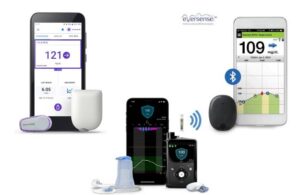
The GLP-1 drug class, which includes Ozempic and Wegovy, has cast a shadow of doubt over diabetes technology of late. This therapeutic class, a glucagon-like peptide 1, has proven to lead to improved blood sugar control and weight loss.
In addition to the popular therapeutics, some companies — like i20 Therapeutics and Vivani Medical — are developing long-term implants that elute GLP-1s.
Positive clinical results from these drugs led to some negative market movement for a few of the biggest names in diabetes technology. Analysts even recently trimmed some forecasts on sales to reflect increased pressure thanks to the GLP-1 updates. The current trend impacted market responses to the likes of Insulet and Embecta in this most recent quarter. It even had an impact on Intuitive Surgical and its surgical robot for bariatric procedures.
Medtronic CEO Geoff Martha tempered expectations of a massive shift in the space, saying the company’s “initial work indicates minimal impact” to its business.
BTIG analysts Marie Thibault and Sam Eiber seem to agree with that sentiment on a broader scale. They hosted a call with Dr. Osama Hamdy of the Obesity Clinical Program at the Joslin Diabetes Center to discuss the GLP-1 impact. Hamdy, an Associate Professor of Medicine at Harvard Medical School, laid out his view on how the therapeutic may — or may not — impact diabetes technologies.
A boom for CGMs?
Thibault and Eiber wrote that Hamdy, a believer in diabetes tech (like CGMs, insulin pumps and automated insulin delivery systems), is also a frequent prescriber of GLP-1s.
Hamdy particularly sees GLP-1s as a positive for glucose monitors — matching outlooks from the likes of Dexcom, a major CGM player. Thibault and Eiber also think GLP-1s could offer a tailwind for the glucose monitoring technology.
“His take on the impact of GLP-1s on CGM adoption was strongly positive, describing it as the ‘brightest future’ imaginable and expecting it to be standard of care in 3-4 years as a tool for tracking glucose variability, time-in-range, and a way to encourage behavioral change,” the analysts said.
Between 90% and 95% of Hamdy’s type 1 diabetes patients (and 30%-40% for type 2) currently use a CGM. Even with the rising popularity of GLP-1s, Hamdy says CGMs represent a complementary tool for people managing their condition.
Thibault and Eiber say that Hamdy expects CGM to become the standard of care for everyone with diabetes in 3-4 years. They noted that a Dexcom survey found that 80% of polled physicians would only feel comfortable taking a patient off GLP-1s without losing the benefits made if they were on a CGM.
Both Dexcom and Abbott — the leaders in the CGM space — retained their “Buy” rating from the analysts. They stayed neutral on long-term implantable CGM maker Senseonics.
What about the impact of GLP-1s on insulin delivery?
Hamdy told the analysts that roughly 30% of his patients take insulin, with 70% of those only on long-acting insulin. He expects the portion of his patients taking insulin may decline by as much as a quarter (20%-25%) in five years.
Thibault and Eiber don’t want to ring alarm bells yet, though.
“We point out this decline is likely more moderate than concerns and stock reactions imply,” they said. “Given the low, single-digit penetration of pumps in the T2D intensive insulin therapy population, the potential impact to the insulin pump [total addressable market] looks relatively minor to us.”
Despite exuding positivity around GLP-1s, Hamdy sees no impact on type 1 diabetes insulin requirements. He still sees “several remaining barriers to entry” for the drug. That could include compliance, side effects and insurance coverage. His testimony was enough for the analysts to declare themselves buyers of Dexcom and Insulet following an “overdone sell-off” in response to the rise of the drugs.
“We don’t foresee a significant risk from GLP-1s to the core [type 1 diabetes] pump and multiple daily injection market,” they said.
Hamdy does think GLP-1s could delay the need for insulin. He says about 15% of all diabetes patients fall into a category known as “severe insulin deficiency.” Those patients fail to make much insulin to begin with, most likely needing a pump or injections down the line.
Another group — severe insulin resistance — makes up 18% of the diabetes population. In some instances, these obese and typically older patients take insulin. Hamdy believes GLP-1 use could help reduce or eliminate the need for insulin. Beyond those subsets, he says the drug will limit progression for those not taking insulin yet and help those on a limited dose to get off insulin.

